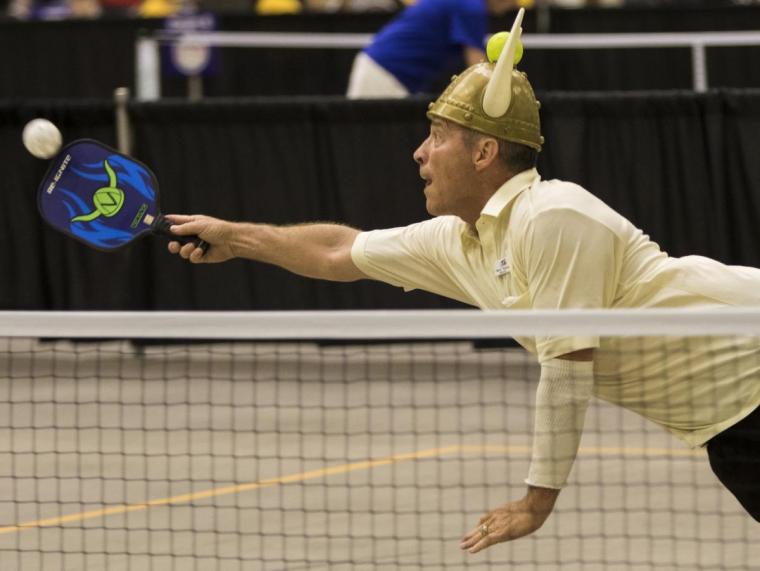

But while the ages are impressive (a 101-year-old cyclist who medals in her event, a 93-year-old bowler who’s still killing it on the lanes, an 87-year-old basketball player – and many others), there are plenty of other numbers to crunch as the Games roll around once more. Here are just a few…
30th: The anniversary of the National Senior Games (they started in 1987)
10,500-plus: How many athletes are expected to descend on Birmingham over the next two weeks
15,000: The number of family and friends expected to travel in
20: Number of sport venues spread across the metropolitan area, with the Birmingham Jefferson Convention Center (BJCC) as the hub of activity.
12,000: The largest number of athletes participating in any Senior Games (Louisville, 2007)
11,000: The second-largest (Pittsburgh, 2005)
2,500: the number of athletes present at the first Games in St. Louis, MO (1987)
$36 million: Economic impact when the Games were in Cleveland
More fun facts: Since the inaugural games in St. Louis in 1987, the National Senior Games has staged 15 biennial competitions, hosted in 12 different states and featuring more than 131,000 participants.
Fun fact on older adult’ spending habits: According to the U.S. Census, Americans 50 and up now spend more on consumer products and services than those under 50, meaning they lead Millennials and Gen X (who have been getting all the attention.) The 50-plus group represents just 45 percent of all adults, so we know they spend more per capita than younger adults—ending the notion that spending slows down after age 50.
19: Number of sports offered (however, within a sport, there may be numerous variations; for example, track & field includes a variety of events; tennis includes men’s and women’s singles, doubles and mixed doubles, etc. – plus, individuals are competing against others in age groups, such as 50-54, 55-59, 60-64 and so on – plus all-age competitions, in which medalists vie for top honors)
900-plus: Number of pickleball players (Note: Pickleball is NSGA’s fastest-growing sport. In 2013, it was first offered and had 362 players. In 2015, there were 652 players. In Albuquerque, New Mexico in 2019, it is expected to grow even more)
51: The age of the youngest competitor this time around (Minimum participation age is 50)
104: The oldest (That sound you’re hearing is the wind draining out of everyone’s excuse for not exercising), and that would be John Zilverberg of Highmore, South Dakota, who medaled at the state level in (get this) two sports: field events (discus throw) and bowling. In addition, 101-year-old Julia Hawkins of Baton Rouge, Louisiana will run the 50- and 100-meter races. 100-year-old upstart D. Paul Miller of Bloomington, Illinois, is also registered for the long jump and the 50-, 100-, and 200-meter races.
Star power: Senior Games 2017's special guest speaker will be running icon Kathrine Switzer, who overcame barriers to become the first woman to officially run the Boston Marathon in 1967, and who returned at age 70 this year to run the marathon again 50 years later. Switzer will also compete in the 10K Road Race on Saturday, June 10, sponsored by Humana.
IX: Title IX was passed long after many athletes were in high school and college, leading to an uptick of women participating in competitive sports at a later age.
Generation Group: Who’s present and competing? Here’s your roll call (definitions courtesy of MarketingTeacher)…
Generation X: Generally agreed to start around 1965, making them the youngest age group represented
Baby Boomers: Born between 1946 and 1964
Mature/Silents: Born between 1927 and 1945
G.I. Generation/Greatest Generation: Born between 1901 and 1926
And yes, you’ll find them all in Birmingham. And while you’re at it, take a good look around at the families cheering on parents, grandparents, aunts, uncles and friends – you’re looking at Gen X (the younger side of it), Gen Y (more commonly known as the Millennials) and Gen Z (sometimes known as the Boomlets.) Because they’ve grown up in an active culture, they’re tomorrow’s Senior Games athletes.
According to Warren Blaney, founder of the event in 1987 that became the Senior Games of today, it’s the sense of competition and enthusiasm that keeps athletes active and keeps them coming back:
“Instead of looking back as they get older, Senior Olympians think about tomorrow. They think, ‘I’ll beat that guy next year.’"

